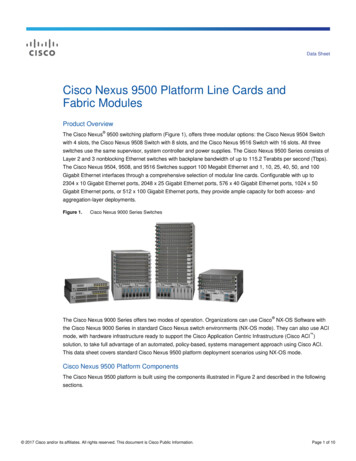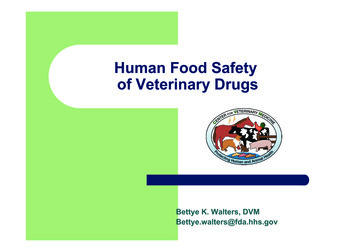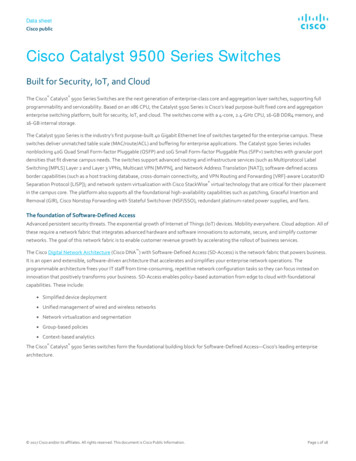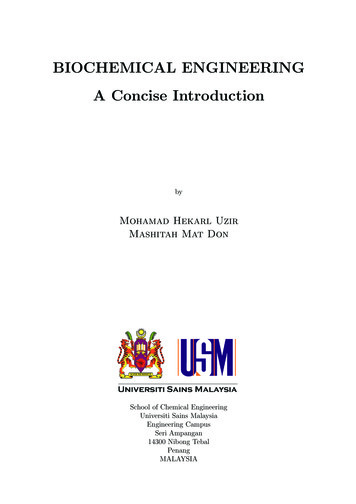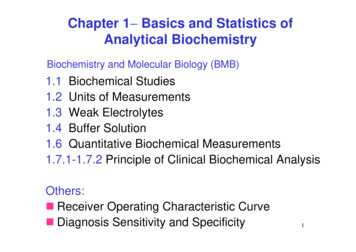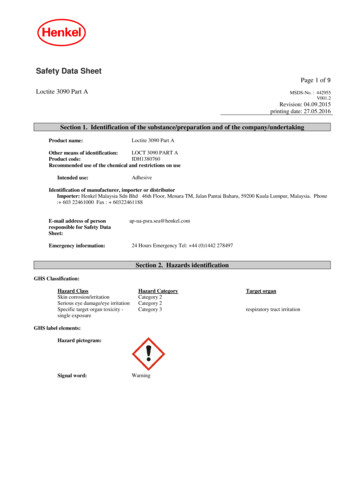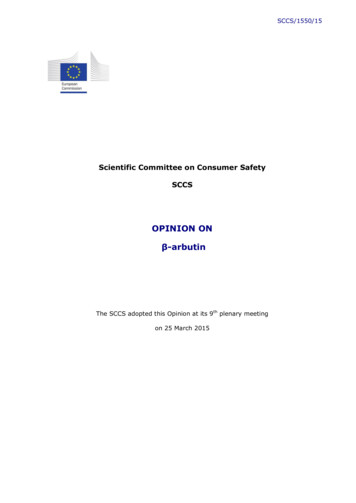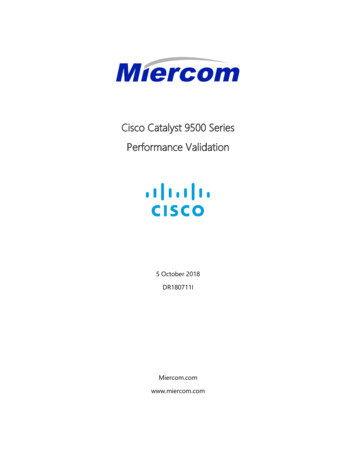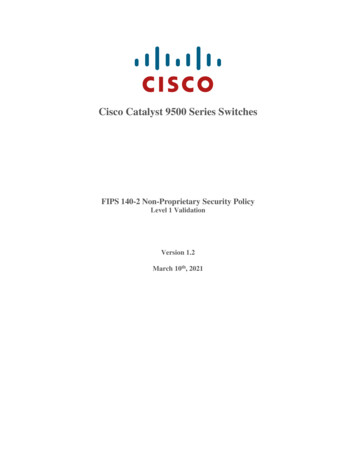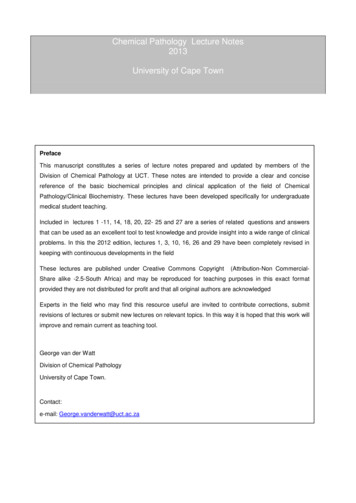
Transcription
Ugbomeh et al. Fisheries and Aquatic 2019) 22:15RESEARCH ARTICLEOpen AccessBiochemical toxicity of Corexit 9500dispersant on the gills, liver and kidney ofjuvenile Clarias gariepinusA. P. Ugbomeh*, K. N. O. Bob-manuel, A. Green and O. TaylorharryAbstractCorexit 9500 is a dispersant commercially available in Nigeria that is used to change the inherent chemical andphysical properties of oil, thereby changing the oil’s transport and fate with potential effects on the environment.The aim of this study was to assess the biochemical (enzymes and electrolyte) toxicity of Corexit 9500 dispersant onthe gills, liver and kidney of juveniles of Clarias gariepinus after exposure for 21 days. One hundred sixty fish wereused without gender consideration. Range-finding tests were conducted over a 96-h period after acclimatisation ofthe test organisms in the laboratory. The test organisms (10/treatment) were exposed to Corexit 9500 in the followingconcentrations—0.00, 0.0125, 0.025 and 0.05 ml/l in triplicate. Twenty-one days later, fish was dissected. 0.5 g from eachof the following organs—gills, liver and kidney tissues—was removed, homogenised and tested for enzymes [superoxidedismutase (SOD), catalase (CAT), alanine aminotransferase (ALT), aspartate transaminase (AST), alkaline phosphatase (ALP)],urea, creatinine and electrolytes (sodium (Na ), potassium (K ), chloride (Cl ), bicarbonate (HCO3 )) following standardmethods. In the gills, SOD and ALT to AST ratio were significantly lower than in control while the creatininewas significantly higher in the toxicant. In the kidney, creatinine was significantly higher in fish exposed tothe toxicant. In the liver, ALP increased in the toxicant while urea was decreased. The mean electrolyteconcentrations (Na , K , Cl and HCO3 ) increased significantly in the concentration of the toxicant (P 0.05). Thealterations observed in the activities of these electrolytes and enzymes indicated that Corexit 9500 interfered withtransamination and metabolic functions of the fish.Keywords: Enzymes, Corexit 9500, Creatinine, Electrolytes, Clarias gariepinusBackgroundClarias gariepinus contributes greatly to the commercial catch of the artisanal fishers in freshwater communities of the Niger Delta and Nigeria at large and is also apreferred species for aquaculturist (Potts et al. 2008;FAO 2010-2016). In Nigeria, the Niger-Delta region hasbeen affected by oil spills, with the resultant use of dispersants thus triggering acute responses in fish andother aquatic lives. Fishes are veritable tools for assessing the effect of pollution in aquatic environments because of their mobile nature (Van der Oost et al. 2003)and some physiological responses from the kidney, gills,liver and heart serve as biomarkers that indicate changesin biological response (ranging from molecular, cellular* Correspondence: ugbomeh.adaobi@ust.edu.ngDepartment of Animal and Environmental Biology, Rivers State University,Nkpolu Oroworukwo, Port Harcourt, Nigeriaand physiological to behavioural changes), caused by exposure or toxic effect of environmental chemicals(Sribanjam et al. 2018). Biochemical markers are quantifiable responses of the exposure of an organism to a pollutant, and the use of different factors is more beneficialthan the use of a single biomarker (Kanchan et al. 2011).The analysis of these biochemical alterations is oftenused to determine the effect of pollutants on the variousorgans in the field or in experimental studies (Fontainhas-Fernandes et al. 2008).Corexit 9500 is one of the several dispersants that arecommercially available in Nigeria and are used to changethe inherent chemical and physical properties of oil,thereby changing the oil’s transport, fate and potentialeffects on the environment (NRC [National ResearchCouncil], 2005). The use of dispersants in Nigeria is restricted to the offshore environment, and Corexit 9500 The Author(s). 2019 Open Access This article is distributed under the terms of the Creative Commons Attribution 4.0International License (http://creativecommons.org/licenses/by/4.0/), which permits unrestricted use, distribution, andreproduction in any medium, provided you give appropriate credit to the original author(s) and the source, provide a link tothe Creative Commons license, and indicate if changes were made. The Creative Commons Public Domain Dedication o/1.0/) applies to the data made available in this article, unless otherwise stated.
Ugbomeh et al. Fisheries and Aquatic Sciences(2019) 22:15Page 2 of 8which is found in our markets is not among the approveddispersants in Nigeria (DPR [Department of PetroleumResources] 2018, 2002). Its availability however impliesthat there is a demand for it. Approximately 250 barrels ofdispersant (Gold Crew, Corexit 9500 and Corexit 9527)was applied in the 1998 rupture of a 24-in. pipeline fromthe IDOHO platform of Mobil in the Qua Ibo Terminal(Olagbende et al. 1999). Corexit 9500A has been observedto increase the mobility of polycyclic aromatic hydrocarbons (a component of crude oil) making them easily available to a larger number of organisms (Zuijdgeest andHuettel 2012) thereby increasing their potential toxicity.There is a paucity of information on the enzymatic andelectrolytic responses of Corexit 9500 on the gills, liverand kidney of the juveniles of Clarias gariepinus. Thisstudy is focused on providing start-up information aboutthe biochemical effects of Corexit 9500 on the gills, liverand kidney and the physicochemical interactions of themedium over a 3-week period.(DO) and temperature of the test media were measured insitu to determine its correctness for fish survival based onrecommended quality parameters (Lelei and Sikoki 2013;APHA 1992) using a standard Hanna multi-parameterprobe (model no: HI98130).MethodsBiochemical analysisEnzymesProcurement of Corexit 9500Corexit 9500 (lot no. BPOJ1337A) was purchased from achemical shop in Port Harcourt in 4-l plastic containersand used in the preparation of the test solution. In orderto determine the appropriate concentration, preliminaryrange-finding test was carried out on a group of five fisheswhich were exposed to six spaced sample dilutions of thestock solution in logarithmic series of 0.1, 1, 3, 5, 7, 9 and15 ml/l for 24 h. The test fishes and control were first observed after an exposure period of 8 h (USEPA 2010) and4-h intervals. The lowest concentration with signs of behavioural anomaly (erratic swimming, hyperventilation)was noticed at 5 ml/l plastic basin after about 8 h.Procurement and acclimatisation of fishLive juveniles (300) of Clarias gariepinus were obtainedfrom a private fish farm in Port Harcourt City and acclimatised for 14 days in the laboratory (Lelei and Sikoki 2013).The mean length of fish was 8.40 2.40 cm and meanweight 3.28 1.28 g SE. The preparation of test stock solution for chronic testing was according to Taylorharry et al.(2019). A 25-l plastic basin was used for dilution of test solution. However, the test concentrations of 0.00 (control),0.0125, 0.025 and 0.05 ml/l of Corexit 9500 in dilutionwater were prepared by separately mixing 0.2, 0.4 and 0.8ml/l of Corexit 9500 in 16 l of water. A 2-ml syringe wasused for measuring the dispersant into the 1 l of water(OECD 1992) while the fish was randomly introduced intothe test basins. The test concentration and water in theplastic basins were renewed after every 2 days. All treatment concentrations had 3 replicates of ten fish, and therewere no gender considerations. The pH, dissolved oxygenDissection and tissue homogenisationAt the end of 3 weeks, the fishes from each concentrationwere immobilised by cervical dislocation before dissection.The gills, liver and kidneys were separated from the anterior and posterior part of the gut, placed in separate Petridishes and preserved in appropriate solution for biochemical analysis. 0.5 g each of the gills, liver and kidney tissueswas homogenised separately on ice, in 4 ml of phosphatebuffer (0.1 M) at pH 7.4 using laboratory pestle and mortar. It was immediately spun at 3000 r/min in a centrifugefor 10 min, and the supernatants were collected for enzymes (SOD, CAT, ALT, AST, ALP), urea, creatinine andelectrolyte (Na , K , Cl , HCO3 ) assay.Superoxide dismutase (SOD) and catalase (CAT) levelswere measured quantitatively according to the sandwichenzyme-linked immunosorbent assay (ELISA) method(Uotila et al. 1981, Lequin 2005) using Elabscience Kits.ALT and AST were estimated according to Reitman andFrankel (1957) method using Randox Kits, while ALPwas estimated according to the phenolphthalein method(Romel et al. 1968) using Teco Kit. Urea was estimatedaccording to the Urease-Berthelot method (Fawcett andScott 1960) using Randox Kit while creatinine was estimated according to the Jaffe-Slot method (Aitken et al.2003) using DiagnosticumZrt Kit. Calculations weremade with formulae based on the methodology of thevarious trade names as follows:pgAbsorbance of test1. SOD ðmlÞ ¼ Absorbanceof standard Concentration of standardngAbsorbance of test2. CAT ðmlÞ ¼ Absorbanceof standard Concentration of standardAbsorbance of test3. ALP ðIUlÞ ¼ Absorbanceof standard Concentration of standardAbsorbance of test4. Urea ðmmoll Þ ¼ Absorbance of standard Concentration of standard5. Creatinine ðμmoll Þ ¼Absorbance 1 of test Absorbance 2 of testAbsorbance 1 of standard Absorbance 2 of standard Concentration of standardElectrolytes (sodium, potassium, chloride and bicarbonateions)Were determined by automation using the ion-selectiveelectrode (ISE) method (Bailey 1976). The samples were
Ugbomeh et al. Fisheries and Aquatic Sciences(2019) 22:15Page 3 of 8aspirated through the probe of the ISE machine and theresults read and copied from the display monitor of themachine.Statistical methodData obtained from this study were collated andsubjected to one-way analysis of variance (ANOVA),and Tukey was used for mean separation using JMPSAS version 12. Results were considered significantat P 0.05.ResultsPhysicochemical parametersThe physicochemical parameters (Table 1) of all the testmedia showed that temperature was not different at P 0.05 (26.17–26.53 C). The DO of control was significantlyhigher than that of the treatments, with the lowest DO inthe 0.05 ml/l treatment. pH was acidic for all treatmentsincluding the control but was more acidic with increasingconcentration of Corexit 9500 (5.84–5.51). The pH ofcontrol was different from treatment 0.025 and 0.05 ml/lbut not from 0.0125 ml at P 0.05.Enzyme activity in the gills, liver and kidneysThe mean level of the enzymes in the gills of C.gariepinus treated with Corexit 9500 is shown inTable 2. AST was significantly highest in treatment0.0125 ml/l (42.00 1.92 μl/l) than other treatments.Control (12.66 0.23 μl/l) had the lowest mean concentration. The AST concentration in all the treatments was higher than the control (P 0.05). Themean level of alanine aminotransferase (ALT) in thegills showed that treatment 0.0125 ml/l (41.33 2.19 μl/l) had the highest mean value while the control (16 μl/l) had the least. The ALT to AST ratio decreased in the treatments (0.88–0.94) compared tothe control. Alkaline phosphatase (ALP) was lowest in0.025 ml/l (12.66 1.09 μl/l) followed by the controlTable 1 Mean SD of physicochemical parameters in exposuretanksTreatments(ml/l)Temp ( C)Mean SDRangeDO (ml/l)Mean SDRangepHMean SDRangeControl26.50 0.14a26.3–26.66.15 0.33a6.1–6.25.84 0.12a5.80–5.850.012526.53 0.35a26.4–26.65.63 0.22b5.5–5.75.56 0.08bc5.55–5.600.02526.17 0.16a26.1–26.35.76 0.41b5.6–5.95.64 0.24b5.62–5.680.0526.31 1.19a26.3–26.45.35 0.22c5.2–5.55.51 0.10c5.44–5.64Groups with the different superscript letters in the same column aresignificantly different from each other (P 0.05)(16.33 4.01 μl/l) while the highest concentration wasrecorded in 0.0125 ml/l (208.66 23.10 μl/l). Themean levels of ALP in the control (16.33 4.01 μl/l)and 0.025 ml/l (12.66 1.09 μl/l) treatment were notdifferent but differed from 0.0125 ml/l and 0.05 ml/l(30.50 2.01 μl/l) (P 0.05).Creatinine was highest inthe fishes exposed to Corexit 9500 than the control.Although there were differences in the mean valuesof creatinine across the treatments, they were not statistically significant (P 0.05).The mean SE of urea recorded from the samplesshowed that those treated with 0.025 ml/l had thehighest concentration (14.40 2.24 μl/l) followed by thecontrol (12.45 1.18 μl/l). Results showed no differencebetween control and other treatments (P 0.05), butthere was a difference between 0.025 ml/l and 0.0125ml/l. The distribution of the enzyme catalase amongthe treated samples showed that the control had thehighest concentration (8.76 1.03 μl/l) followed by0.05 ml/l (7.27 1.12 IU/l) then 0.0125 ml/l (5.68 0.94 IU/l) while 0.025 (4.86 0.83 IU/l) was the least.The control differed significantly from 0.025 ml/l (P 0.05) but was not significantly different from 0.0125ml/l and 0.05 ml/l (P 00.05) as shown in Table 2.All treatment values were lower than the control, andthere was also a variation in the mean concentrationsof SOD across the treatments. All fishes exposed toCorexit 9500 had SOD levels lower than the control.In the kidney, creatinine was higher in the exposedfishes than in the control. Levels increased with increasing concentration of the dispersant (Table 3). AST, ALT,urea and catalase levels were not different in the controland treatments (P 0.05). The ALT to AST ratio increased in higher exposure concentrations. SOD andALP levels in exposed fishes were different from thecontrol (P 0.05) at concentrations except 0.025 ml/l.In the liver (Table 4), AST and ALT concentrationlevels were not different between control and treatmentsexcept at 0.05 ml/l (P 0.05). ALP concentrations weredifferent from the treatments (P 0.05) except in 0.025ml/l. The control differed significantly from the treatments (P 0.05) for urea, whereas creatinine, catalaseand SOD treatments did not differ significantly from thecontrol at P 0.05.Electrolyte levelsGillsThe Na , K , Cl and HCO3 ion concentrations in thegills of C. gariepinus exposed to Corexit 9500 were alldifferent from the control at P 0.05 (Table 5). Higherconcentrations of Na , K and Cl with increasing treatment concentrations and the reverse for HCO3 wasobserved.
Ugbomeh et al. Fisheries and Aquatic Sciences(2019) 22:15Page 4 of 8Table 2 Mean ( SE) concentrations of gill enzymes of C. gariepinus treated with Corexit 9500 dispersantTreatments(ml/l)SOD (mmol/l)CAT (mmol/l)ALT (Iμ/l)AST (IU/l)ALP (IU/l)Urea (IU/l)Creatinine (IIU/l)ALT toAST (ratio)Control2.79 0.23a*8.76 1.03a16.00d12.66 0.23d16.33 4.01c12.43 1.18ab190.00a1.26babaaaba0.01250.35 0.025.68 0.9441.33 2.1942.00 1.92208.66 23.1011.44 0.97123.33 2.970.980.0250.92 0.01ab4.86 0.83b27.00b30.66 0.92b12.66 1.09c14.40 2.24a139.66 9.18c0.88cbc0.930.05ab0.86 0.01abc7.27 1.1221.50 3.0223.00 2.10ab30.50 2.0112.32 4.01132.11 2.01*Groups with the different superscript letters in the same column are significantly different from each other (P 0.05)EnzymesKidneysThe Na and K ion concentrations in the kidney of fishexposed to Corexit 9500 were not different from thoseof the controls (P 0.05). Also, the Cl and HCO3 concentrations of the controls were not different from thelower exposure concentrations of 0.0125 ml/l and 0.025ml/l (P 0.05) but were different from levels of fish exposed to 0.05 ml/l of Corexit 9500 (P 0.05) (Table 6).LiverNa and HCO3 levels in the liver of C. gariepinus in thecontrol and 0.025 ml/l exposure level were not different (P 0.05), but were different with the higher exposure concentrations (P 0.05). Levels of Na , K and Cl increased with increasing exposure concentrations, but HCO3 decreased with increasing exposure concentrations of the dispersant (Table 7).DiscussionsPhysicochemical parametersThe decrease in dissolved oxygen (DO) with increasingconcentrations of Corexit 9500 could be attributed to theability of the dispersant to reduce soluble oxygen in themedium. The reduced dissolved oxygen with higher concentration of Corexit 9500 might have caused stress in thefish resulting in suffocation and fish death during the acutetesting. This perception corroborates prior reports of Baden(1982) that water bodies contaminated with toxicants andother aquatic pollutants usually have a high biological oxygen demand and a reduction in DO. Boyd and Lichthoppler(1979) also reported that low DO of water could havestress-related adverse outcomes on the growth and behaviour of fish. The increased acidity in the treatments may alsohave impacted the fish.In this study, the mean concentration of some of theenzymes increased as the concentration of the toxicant increased while some decreased in the organs examined indicating elevation or decrease observed as dose-dependent.This is in accordance with the report of Pesce et al. (2008),who noticed that the disparity in metabolic enzyme activities in fish was directly proportional to the concentrationof the toxicant. In fish, the gills are critical organs of respiration and respiratory distress has been observed to be oneof the early symptoms of water poisoning in fish(Ortiz et al. 2003). The enzyme activities in the gillsof C. gariepinus exposed to Corexit 9500 increasedsignificantly when compared to the control (especiallyAST, ALT and ALP). This may be due to an effect onthe micellar layer on fish gill surface responsible forthe absorption of anthropogenic substances from thepolluted environment through epithelial cells with thesubsequent elevation of enzyme activities (Monferranet al. 2008). Enzymes are considered as sensitive biochemical toxicity indicators in the organs of fish. Theenzymes AST and ALT are transaminases basicallyfound in most organs of fish, catalyse transaminationbetween an amino acid and α-keto acid and are important in protein synthesis (Fanta et al. 2003).There was a reduction in creatinine levels in the gillsand an increase in the kidney of fish exposed to Corexit9500 when compared to the control. This shows variations in the effect of the toxicant on fish organs. In theliver, there was no significant difference between controland treatments. Creatinine kinase (CK) is found in several tissues, and it catalyzes the degradation of wasteproduct creatinine. Could increase or decrease in creatinine levels in the gills and kidney respectively be as aTable 3 Mean ( SE) values of kidney enzymes in C. gariepinus treated with Corexit 9500 dispersantTreatments(ml/l)SOD (mmol/l)CAT (mmol/l)ALT (IU/l)AST (IU/lALP (IU/l)Control4.70 0.98a*10.79 1.99a4.00 1.00a4.50 0.64a7.00b0.0125c1.50 0.07aa14.11 2.13aaa5.0014.72 1.10aa6.00aUrea (IU/l)30.66 1.24abCreatinine (IU/l)ALT toAST (ratio)30.00a0.89a76.66 2.91b0.83ac11.33 2.630.0254.44 0.9821.19 2.145.33 1.014.66 0.176.66 1.2324.09 3.62100.001.140.052.91 0.71b14.33 4.10a4.00 0.91a3.50 0.24a31.50 2.01a12.55 2.30a200.00d1.14*Groups with the different superscript letters in the same column are significantly different from each other (P 0.05)
(2019) 22:15Ugbomeh et al. Fisheries and Aquatic SciencesPage 5 of 8Table 4 Mean ( SE) values of liver enzymes in C. gariepinus treated with Corexit 9500 dispersantTreatments (ml/l)SOD (mmol/l)CAT (mmol/l)ALT (IU/l)AST (IU/l)ALP (IU/l)Urea (IU/l)Control1.76 0.03a*22.24 2.18a5.33 0.45b4.33 0.14a10.33 0.91c15.69 0.93a113.33 2.13ac0.01251.67 0.10.0250.05aaab10.96 1.028.33 0.230.77 0.0a11.54 1.93a4.50 0.41baa1.67 0.011.74 0.97aa5.33 0.915.50 0.72aa16.00 1.20b12.33 0.21Creatinine (IU/l)223.66 1.7211.38 1.11150.00 3.14a14.00 1.87c12.24 1.09bc55.00 1.96abb76.33 2.2413.09 0.9130.00 4.81a*Groups with the different superscript letters in the same column are significantly different from each other (P 0.05)result of increased or decreased activity of CK broughtabout by differing effects of the toxicant? This howeverwas not measured, as elevated CK will result in decreased creatinine levels (Sparling 2016) which might indicate muscle damage. Creatinine leaves the muscle andenters the blood where it becomes a waste item to agreater extent from the muscle breakdown. It is excretedby filtration through the glomeruli of the kidney and discharged as urine (Adamu and Kori-Siakpere 2011). Consequently, it is regularly utilised in the analysis of renalfunction test particularly the glomeruli filtration rate(Murray et al. 2003). Akani and Gabriel (2016) reporteda significant decrease in creatinine level of C. gariepinusexposed to concentrations of oilfield wastewater.Urea is a waste product metabolised in the liver andan end product of protein catabolism excreted by thekidney. The level of urea in the fishes exposed to concentrations of Corexit 9500 was significantly differentfrom the control in the gills and liver but not in the kidney. This means Corexit may affect the metabolism ofurea in the liver but might not affect its elimination inthe kidney. Mahmoud et al. (2012) recorded a significantincrease in urea and creatinine when they exposed C.gariepinus to mercury chloride. The low value of urea inthe liver in this study may be attributed to its inability tometabolise protein as reported by Kori-Siakpere (2000).The main function of the liver is the detoxification ofchemical substances that come in contact with organisms by metabolising xenobiotics to non-harmful substances. Consequently, in the event of contact withxenobiotics or toxicants, the chemistry of the liver maybe distorted to counteract the adverse outcome of pollutants (Abdullaev et al. 1985; Obomanu et al. 2009).Enzymes and electrolytes are components of liverfunction test, which are dependable indicators of livermetabolism and wellness of the organism under test(Sreekala and Zutshi 2010; Iweala and Okeke 2005;Uboh et al. 2011). The observed increase in liver enzymes was an indication of underlying liver injury in thefish. Elevation of tissue enzymes AST, ALT and ALP indicates liver damage which may be hepatitis or necrosisof cells (Gabriel and George 2005; Yousafzai and Shakoori 2011). Toxicants have been observed to amplifythe cellular membrane permeability, thereby enhancingenzyme leaching or leaking out of the liver to the blood,or they may have decreased the permeability, forcing theenzymes to accumulate in the cells (Gabriel et al. 2009).Increase in AST and ALT suggests active transamination,so as to maintain energy cycle (Adams et al. 1996). ALPin the cellular external membrane plays a significant rolein phosphate metabolism, and it prevents the externalmembrane from being damaged (Durrieu and TranMinh 2002). The increase in this enzyme implies overproduction of phosphate bound esters, which helps inthe preservation of cell integrity (Gabriel et al. 2009;Gabriel and George 2005).Superoxide dismutase (SOD) is a collection of metalloenzymes that play a vital antioxidant role, and comprises themain protection against the toxic effects of superoxide radicals in aerobic organisms. SOD catalyses the conversion ofsuperoxide radicals to hydrogen peroxide (H2O2) and oxygen, and it is the first enzyme of response in oxi-radicals(Kappus 1985). In the liver, the mean concentration of SODdecreased significantly as the concentration of the toxicantincreased (P 0.05). The SOD was reduced in the gills,liver and kidney. This means that there were no oxi-radicalsinitiated by the Corexit 9500. This finding in this study disagrees with Mandeep and Rajinder (2017), who observedoxidative stress response in the liver, kidney and gillsof Ctenopharyngodon idellus exposed to chlorpyrifosTable 5 Mean ( SE) concentration values of electrolytes in the gills of C. gariepinus treated with Corexit 9500Treatments (ml/l)Na (mmol/l)Control138.33 5.27c*bK (mmol/l)Cl (mmol/l)HCO3 (mmol/l)4.26 0.65c97.33 3.76c24.00 2.03aab20.66 1.99b0.0125151.33 9.575.90 0.43103.00 5.30.025154.00 12.01ab5.70 1.12ab104.33 5.86ab0.05a155.00 3.45b5.55 0.97a106.00 3.67*Groups with the different superscript letters in the same column are significantly different from each other (P 0.05)20.00bc18.50 2.86c
(2019) 22:15Ugbomeh et al. Fisheries and Aquatic SciencesPage 6 of 8Table 6 Mean ( SE) values of electrolytes in the kidney of C. gariepinus treated with Corexit 9500Treatments (ml/l)ControlNa (mmol/l)K (mmol/l)a*137.50 11.03.55 0.12HCO (mmol/l)b24.50 2.31a96.00137.33 4.914.16 0.0997.66 7.2324.66 3.33a0.025138.33 7.10a4.00a96.66 5.21b22.66 3.01aba136.50 4.23aCl (mmol/l)0.01250.05aaa4.25 0.47aba20.50 6.02b99.50 2.87*Groups with the different superscript letters in the same column are significantly different from each other (P 0.05)(a toxicant). The significant decrease of SOD in gillscould be attributed to an inability to produce the enzyme in the presence of Corexit 9500, also indicatingsome form of stress.Catalase (CAT) is an enzyme that is situated in the peroxisomes and assists in the removal of hydrogen peroxide,which is metabolised to oxygen and water (Van Der Oostet al. 2003). The concentration of catalase fluctuatedacross the various concentration of the treatment showingno significant difference between the control and thetreatments (P 0.05). The initial elevation in the enzymelevel indicates an elevated antioxidant level in order toneutralise the impact of reactive oxygen species (ROS).Furthermore, the decrease in CAT activity might be as aresult of influx of superoxide radicals. The current observations are in agreement with the findings of otherworkers—Ballesteros et al. (2009) (Jenynsia multidentataexposed to endosulphan) and Ferreira et al. (2010)(Rhamdia quelen exposed to agrochemicals).ElectrolytesThe examination of biochemical reactions of electrolytes inan organism exposed to a toxicant revealed that aquaticpollutants act by destroying the permeability of cell membranes replacing the structural or electrochemical important elements in the cell which cause functional failures(Yelwa and Solomon 2016; Adhikari et al. 2004). The dualfunction of electrolytes in animals lies in controlling fluiddistribution and maintaining a normal muscular irritability(Abernathy et al. 2003). Na , Ca2 and K are the main cations of the extracellular fluid while carbonate HCO3 andchloride ions (Cl ) are the chief anions of the intracellular fluid (Celik et al. 2005). In this study, themean level of Na , Cl and K increased significantlyin the gills of C. gariepinus while HCO3 decreasedwith increasing concentration of Corexit 9500 in the liver.The increase in the ionic concentrations and decrease inHCO3 of the treated samples could be as a result of theeffects of Corexit 9500 on the electrolyte balance of C.gariepinus. In the kidney, there was a decrease in HCO3 concentration but Cl increased with increase in the concentration of Corexit 9500, while in the gills, Na and K were not different from the control. Circulating levels ofNa have been shown as a valuable measurement of stress,mainly due to the active movement of this ion across thegill structure, depending on its concentration in the external medium (Bentley 1971).Conclusion and recommendationsIn conclusion, Corexit 9500 elevated some enzymes(AST, ALT, ALP) in the test organism, inhibited the production of some enzymes (creatinine, CAT, SOD) andproduced a significant change in the levels of urea in theliver. Some electrolyte levels (Na , K , Cl ) were elevated, while there was inhibition in the levels of HCO3 in the test organism.Corexit 9500 can be concluded to be highly toxic toC. gariepinus even at very low concentration (LC50 of0.115 ml/l at 96 h) as its administration altered the levelof liver and gill enzymes, and intracellular electrolytes,thereby affecting adversely the anti-oxidative defense system in various organs of the fish.The physicochemical parameters measured could provideuseful information for evaluating the toxicological effects ofCorexit 9500 on the fish and help in the diagnosis of thepollution. Study on long-termeffects of dispersants ongrowth, reproduction and normal functions of the aquaticorganism are recommended. Concentrations of dispersantused in oil spills should be appropriately assessed, and theiruse near fish breeding grounds should be avoided.Table 7 Mean SE values of electrolytes in the liver of C. gariepinus treated with Corexit 9500 dispersantTreatments (ml/l)Na (mmol/l)Control136.66 2.90b*Cl (mmol/l)3.83 0.24c97.33 2.17c23.00 1.71a142.00 3.375.03 0.82101.66 5.1822.33 3.01a0.025152.50 2.12a5.35 0.12ab104.00. 4.13ab19.50 1.71ba152.66 3.24bHCO (mmol/l)0.01250.05bK (mmol/l)a5.50 0.67ba105.00 2.17*Groups with the different superscript letters in the same column are significantly different from each other (P 0.05)19.66 1.11b
Ugbomeh et al. Fisheries and Aquatic Sciences(2019) 22:15AbbreviationsALP: Alkaline phosphatase; ALT: Alanine amino transferase; AST: Aspartatetransaminase; Ca : Calcium ion; CAT: Catalase; Cl : Chloride ion;DO: Dissolved oxygen; GFR: Glomerular filtration rate; HCO3 : Bicarbonateion; K : Potassium ion; Na : Sodium ion; ROS: Reactive oxygen species;SOD: Superoxide dismutaseAcknowledgementsWe want to thank the staff of C. Powell Laboratory of the University of PortHarcourt for the use of their laboratory facilities, Mr. Choko for statisticalanalysis and Sokari fish farms for providing the juvenile Clarias.Authors’ contributionsAPU and TO designed the work and wrote the first draft. BKNO, TO and GAdid the analysis and interpretation of data. APU and BKNO wrote the finaldraft. All authors read and approved the final submitted version.FundingThe project was funded by the authorsAvai
the biochemical effects of Corexit 9500 on the gills, liver and kidney and the physicochemical interactions of the medium over a 3-week period. Methods Procurement of Corexit 9500 Corexit 9500 (lot no. BPOJ1337A) was purchased from a chemical shop in Port Harcourt in 4-l plastic containers and used in the preparation of the test solution. In order
